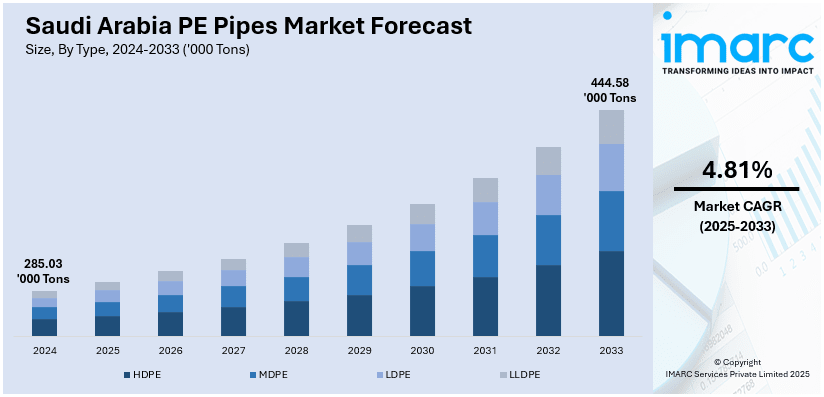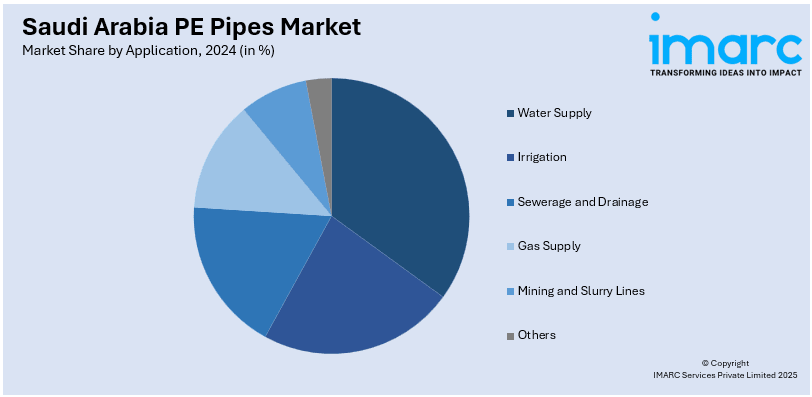
Saudi Arabia PE Pipes Market Size, Share, Trends and Forecast by Type and Application, 2025-2033
Saudi Arabia PE Pipes Market Size and Share:
The Saudi Arabia PE Pipes market size was valued at 285.03 Thousand Tons in 2024. Looking forward, IMARC Group estimates the market to reach 444.58 Thousand Tons by 2033, exhibiting a CAGR of 4.81% during 2025-2033. Rising infrastructure projects, water supply expansion, oil and gas sector demand, urbanization, sewage system upgrades, durability preference, lightweight handling, and government initiatives promoting sustainable piping solutions are some of the factors propelling the growth of the market
|
Report Attribute
|
Key Statistics
|
|---|---|
|
Base Year
|
2024
|
|
Forecast Years
|
2025-2033
|
|
Historical Years
|
2019-2024
|
|
Market Size in 2024
|
285.03 Thousand Tons |
|
Market Forecast in 2033
|
444.58 Thousand Tons |
| Market Growth Rate 2025-2033 | 4.81% |
There are several factors contributing to Saudi Arabia PE pipes market is witnessing several notable trends. There is a growing adoption of high-density polyethylene (HDPE) pipes due to their strength, flexibility, and resistance to corrosion and chemicals, making them suitable for harsh environments. The push toward sustainable water management is driving demand in irrigation and water distribution. Smart city development and large-scale infrastructure projects under Vision 2030 are expanding applications in telecom, sewage, and gas distribution. Manufacturers are also focusing on product innovation, such as multilayered and UV-resistant pipes. The market is shifting toward automated pipe production for better efficiency and quality. Additionally, partnerships with construction and oil companies are increasing, enabling customized solutions. Local manufacturing is being strengthened to reduce import dependence, aligning with government initiatives for industrial growth and self-sufficiency.

Ongoing investments in water distribution infrastructure are boosting Saudi Arabia PE pipes market demand for high-density polyethylene (HDPE) pipes. Projects involving long-distance pipeline installations are increasing the need for PE pipes in various diameter categories, especially for underground and municipal applications. This shift supports higher production volumes and encourages domestic sourcing. As development initiatives progress, PE pipe usage is expected to remain strong in the utility and construction sectors nationwide. For instance, in June 2023, Saudi Arabia’s National Water Company awarded a USD 130 Million EPC contract for the Bisha Drinking Water Networks project. The scope includes 95 kilometers of HDPE pipes (110–200mm diameter). This project marked a significant demand surge for PE pipes in the Kingdom, reinforcing HDPE pipe usage in large-scale water infrastructure and supporting the domestic polyethylene pipe manufacturing sector.
Saudi Arabia PE Pipes Market Trends:
Oil and Gas Exploration Driving PE Pipe Demand
Saudi Arabia’s robust oil and gas sector continues to be a major catalyst for PE pipe consumption. These pipes are essential for upstream and midstream activities, offering chemical resistance, long service life, and minimal maintenance. Their ease of fusion welding and adaptability in remote installations further enhance operational efficiency in energy projects. Additionally, the harsh desert environment makes corrosion-resistant PE pipes a practical choice for long-term use in hydrocarbon transport. The growing investment in exploration and production, along with infrastructure expansion in remote oilfields, is further driving demand for durable, lightweight, and cost-effective PE piping systems. According to OPEC data, Saudi Arabia held an estimated 17% of the world’s proven oil reserves and 22% of OPEC’s proven reserves in 2023.
Real Estate Expansion Boosting Infrastructure Pipe Applications
The rapid pace of urbanization and residential development in Saudi Arabia is amplifying the need for efficient water and utility networks. PE pipes are increasingly favored in building infrastructure due to their durability, flexibility, and cost-efficiency. Their ability to withstand surge events and temperature fluctuations makes them ideal for water distribution in newly built communities and high-density developments. The ongoing infrastructure upgrades in line with Vision 2030 further reinforce their relevance across real estate and utility projects. For instance, the residential sector dominates Saudi Arabia’s real estate landscape. In the first half of 2024 (H1), the number of real estate transactions surged by 38%, with total transaction values rising to USD 34 Billion.
Rising Investments in Insulated Piping Solutions
A rising uptake of insulated polyethylene piping systems, driven by expanding infrastructure development across urban and industrial zones, is leading to Saudi Arabia PE pipes market growth. These systems are favored for their thermal efficiency, corrosion resistance, and suitability for extreme desert environments. Their use is expanding in applications such as district cooling, water transmission, and industrial utilities, where long service life and minimal maintenance are essential. Increasing focus on sustainable and energy-efficient construction practices is also supporting the wider deployment of advanced insulation technologies within the country’s pipeline networks. For example, in July 2024, Perma-Pipe International Holdings, Inc. secured USD 10 Million in contracts for infrastructure projects in Riyadh, Madinah, and Mekkah, Saudi Arabia. These projects would utilize the XTRU-THERM insulation system.
Saudi Arabia PE Pipes Industry Segmentation:
IMARC Group provides an analysis of the key trends in each segment of the Saudi Arabia PE pipes market, along with forecasts at the regional level from 2025-2033. The market has been categorized based on type and application.
Analysis by Type:
- HDPE
- MDPE
- LDPE
- LLDPE
HDPE stands as the largest component in 2024, holding around 62.9% of the market, driven by strong demand in water supply, sewage, and gas distribution systems. Its corrosion resistance, durability, and flexibility make it suitable for harsh desert environments. Growing infrastructure investments under Vision 2030, including urban expansion and utility upgrades, are accelerating HDPE adoption. Government focus on improving water management and reducing leakage losses further boosts its usage. The material’s lightweight nature eases transportation and installation, cutting project costs. Additionally, HDPE’s recyclability supports sustainability goals, aligning with national environmental strategies and reinforcing its preference across key infrastructure segments.
Analysis by Application:

- Water Supply
- Irrigation
- Sewerage and Drainage
- Gas Supply
- Mining and Slurry Lines
- Others
Based on Saudi Arabia PE pipes market outlook, water supply leads the market with around 54.2% of market share in 2024. This is driven by the rising demand for efficient water distribution systems amid rapid urbanization and population growth. Government efforts to modernize aging water infrastructure and expand access to clean water in remote areas are key factors. Projects under Vision 2030, especially in smart cities and rural development, are increasing pipeline installations. PE pipes’ leak resistance, durability, and ease of installation make them ideal for large-scale water networks. Additionally, the region’s arid climate and limited freshwater resources necessitate reliable, low-maintenance piping systems for long-term water conservation.
Competitive Landscape:
The Saudi Arabia PE pipes market is experiencing significant growth, driven by government initiatives like Vision 2030, which focus on infrastructure development and water management. This has led to increased demand for PE pipes in water supply, sewage systems, and irrigation. The emphasis on infrastructure projects and sustainability initiatives is a common practice in the current market scenario. The report provides a comprehensive analysis of the competitive landscape in the Saudi Arabia PE pipes market with detailed profiles of all major companies, including:
- Saudi Plastic Products Company Ltd. (SAPPCO)
- Alwasail Industrial Company
- Arabian Gulf Manufacturers Ltd.
- Saudi Arabian Amiantit Company
- Al Jubail Sanitary Pipe Factory
- IKK Group
Latest News and Developments:
- January 2025: Strohm secured a contract to supply 33 kilometers of thermoplastic composite pipes for Aramco’s Fadhili gas plant expansion in Saudi Arabia. This marked Strohm’s first commercial onshore project in the region, following a successful pilot with Saudi Aramco. The project introduced Strohm’s electrofusion coupler, a non-metallic, corrosion-free joint designed for buried applications.
- January 2025: SABIC unveiled its new polypropylene pipe solution, SABIC VESTOLEN P9421, made with a random copolymer. The material offers high thermal stability, durability, and resistance to high pressures and temperatures. It is designed for cold and hot water pipes, ensuring safe drinking water transport. The solution met specific pipe application requirements, enhancing quality and versatility.
Saudi Arabia PE Pipes Market Report Scope:
| Report Features | Details |
|---|---|
| Base Year of the Analysis | 2024 |
| Historical Period | 2019-2024 |
| Forecast Period | 2025-2033 |
| Units | Million USD, Thousand Tons |
| Scope of the Report |
Exploration of Historical and Forecast Trends, Industry Catalysts and Challenges, Segment-Wise Historical and Predictive Market Assessment:
|
| Types Covered | HDPE, MDPE, LDPE, LLDPE |
| Applications Covered | Water Supply, Irrigation, Sewerage and Drainage, Gas Supply, Mining and Slurry Lines, Others |
| Companies Covered | Saudi Plastic Products Company Ltd. (SAPPCO), Alwasail Industrial Company, Arabian Gulf Manufacturers Ltd., Saudi Arabian Amiantit Company, Al Jubail Sanitary Pipe Factory, and IKK Group |
| Customization Scope | 10% Free Customization |
| Post-Sale Analyst Support | 10-12 Weeks |
| Delivery Format | PDF and Excel through Email (We can also provide the editable version of the report in PPT/Word format on special request) |
Key Benefits for Stakeholders:
- IMARC’s report offers a comprehensive quantitative analysis of various market segments, historical and current market trends, market forecasts, and dynamics of the Saudi Arabia PE pipes market from 2019-2033.
- The Saudi Arabia PE pipes market research report provides the latest information on the market drivers, challenges, and opportunities in the regional market.
- The study maps the leading, as well as the fastest-growing, regional markets. It further enables stakeholders to identify the key markets within the region.
- Porter's five forces analysis assist stakeholders in assessing the impact of new entrants, competitive rivalry, supplier power, buyer power, and the threat of substitution. It helps stakeholders to analyze the level of competition within the Saudi Arabia PE pipes industry and its attractiveness.
- Competitive landscape allows stakeholders to understand their competitive environment and provides an insight into the current positions of key players in the market.
Key Questions Answered in This Report
The PE pipes market in Saudi Arabia was valued at 285.03 Thousand Tons in 2024.
The Saudi Arabia PE pipes market is growing due to increasing infrastructure development, expanding construction and irrigation projects, rising demand for durable, corrosion-resistant piping solutions, and government initiatives focused on water conservation and smart city planning. Urbanization and oil and gas sector investments are further boosting market demand for PE pipes.
The PE pipes market is projected to exhibit a CAGR of 4.81% during 2025-2033, reaching a value of 444.58 Thousand Tons by 2033.
Based on type, HDPE held the largest share of the market with 62.9% in 2024.
Some of the major players in the PE pipes market include Saudi Plastic Products Company Ltd. (SAPPCO), Alwasail Industrial Company, Arabian Gulf Manufacturers Ltd., Saudi Arabian Amiantit Company, Al Jubail Sanitary Pipe Factory, IKK Group, etc.
Need more help?
- Speak to our experienced analysts for insights on the current market scenarios.
- Include additional segments and countries to customize the report as per your requirement.
- Gain an unparalleled competitive advantage in your domain by understanding how to utilize the report and positively impacting your operations and revenue.
- For further assistance, please connect with our analysts.
 Inquire Before Buying
Inquire Before Buying
 Speak to an Analyst
Speak to an Analyst
 Request Brochure
Request Brochure
 Request Customization
Request Customization




.webp)




.webp)












